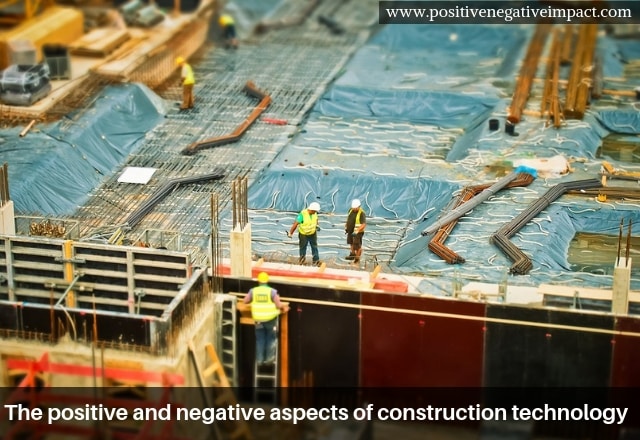As hard as it may be to believe, some of the earliest advances in construction technology took place some two thousand years ago with the invention of concrete. In fact, some of the ancient architectural wonders, including the Pantheon (126 AD) in Rome, with the world’s largest freestanding cupola would not have been possible without the same. Since then, construction has undergone a rapid change, and evolution of sorts, especially in the last few decades that made the world’s largest skyscraper, the Burj Khalifa in Dubai possible. But it should be pointed out that rampant construction does not come without its own negative overtones and that is why it is essential that we take a closer look at some of the positive and negative aspects of construction technology.

Positive aspects of construction technology
- Scope: Thanks to the various advances in construction technology it is now possible to develop and build large-scale projects in the shortest time possible. As a result, construction companies are able to undertake large sized projects, including building some of the largest skyscrapers in the world and develop the same in record time. Moreover, thanks to advances in construction technologies, companies are able to develop projects under the most challenging of circumstances and even reclaim land back from the sea, create man-made islands, when required; none of this would be possible without the various advances in construction technology.
- Time: The demand for new homes is at an all-time high which is only natural given the exponential increase in population numbers. With demand for cheaper, affordable housing shooting up, construction companies are often under pressure to complete various housing projects in record time. Now, thanks to construction technology, companies are able to do just that and construct, develop and complete large-scale housing development projects with a quick turnover.
- Protection: These days it is possible to build buildings in an extremely short amount of time and at the same time, ensure that the building in question is robust, strong and is well protected against natural disasters such as earthquakes. This is especially important for those buildings that are located in a seismically active zone and as a result, often experience frequent earthquakes. With the advances in construction technology, companies can now construct earthquake resistant buildings which are good given the fact that most of the casualties in an earthquake occur as a result of building collapse on account of an earthquake.
Negative aspects of construction technology
- Environmental degradation: As more and more land is reclaimed back from the wild in the quest to develop the same for various construction-related projects, construction companies are helping contribute to the global warming, as a result of deforestation and destruction of natural habitats. A recent study established that we lose over 1000 species, both flora and fauna each year due to loss of natural habitats. Most construction companies, when reclaiming forested land often do not bother to assess the environmental impact and this has taken a toll on the local environment with disastrous consequences.
- Localized health issues: Given the scarcity of prime properties, construction companies have started reclaiming land from the sea and from local water bodies including marshes. While all of this has been made possible with the various advances in construction technology over the last few decades, the fact remains that building housing condominiums’ near a marsh can put residents at risk of contracting malaria and other diseases. Most construction companies do not bother to assess a particular area in depth since they are already under enormous pressure to complete a project – the end result is that the health of these residents can get impacted as a result of shoddy work on the part of the construction company.
- Safety issues: As most construction companies are under enormous pressure to wrap up their projects in the shortest time possible and to hand over the same, they often try to cut corners to achieve the near impossible. The end result is that the building in question could have been built using inferior materials; it may lack a fire escape, emergency evacuation plans and more. The fact remains that as more construction companies race against time to complete their project, the safety is often one of the first things that most of these companies compromise on.
These are some of the positive and negative aspects of construction technology; it remains to be seen if the various construction companies can offset some of the negative aspects of construction technology in both the short term and long term.
- Tulip Mania – The Story of One of History’s Worst Financial Bubbles - May 15, 2022
- The True Story of Rapunzel - February 22, 2022
- The Blue Fugates: A Kentucky Family Born with Blue Skin - August 17, 2021
